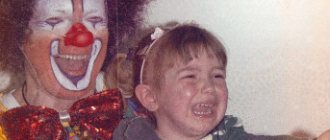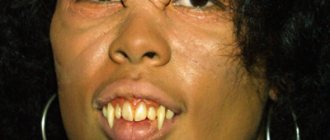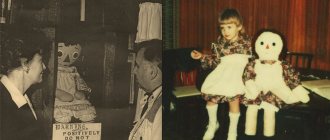Mental health is a very sensitive topic. Clinical manifestations of mental disorders depend on the age of the child and the influence of certain factors. Often, due to fear for future changes in their own life, parents do not want to notice some problems with the psyche of their child.
Many people are afraid to catch the sidelong glances of their neighbors, feel the pity of their friends, or change their usual life order. But the child has the right to qualified, timely assistance from a doctor, which will help alleviate his condition, and in the early stages of certain diseases, cure a mental disorder of one spectrum or another.
One of the complex mental illnesses is childhood psychosis. This disease is understood as an acute condition of a child or a teenager, which manifests itself in his incorrect perception of reality, his inability to distinguish the real from the imaginary, and his inability to really understand what is happening.
Features of childhood psychoses
Mental disorders and psychoses in children are not diagnosed as often as in adult men and women. Mental disorders come in different types and forms, but no matter how the disorder manifests itself, no matter what symptoms the disease has, psychosis significantly complicates the life of the child and his parents, prevents him from thinking correctly, controlling actions, and building adequate parallels in relation to established social norms.
Childhood psychotic disorders are characterized by:
- Delayed development of skills and intelligence. This feature appears in most cases. But there are diseases, for example, autism, during which the child has bright and advanced abilities in some area of activity. Experts say that in the early stages, mental disorders in children are difficult to distinguish from simple developmental delays, and therefore it is impossible to recognize a mental disorder.
- Problems with social adjustment.
- Violation of interpersonal relationships.
- A sublime and special attitude towards inanimate objects.
- Supporting monotony, not accepting changes in life.
Childhood psychosis has different forms and manifestations, which is why it is difficult to diagnose and treat.
How to notice that a child has psychological trauma?
The general criterion for diagnosing psychological trauma is a sudden change in the behavior and emotional state of the child. For example, a child was cheerful, active and suddenly became depressed, withdrawn, and does not want to do anything.
Emotional symptoms:
- fears;
- anxiety;
- tics or compulsions;
- frequent mood changes;
- depression, isolation;
- rage, irritability;
- decreased concentration.
Physical symptoms:
- sleep disturbances (difficulty falling asleep, nightmares);
- enuresis, encopresis;
- loss of appetite or, conversely, overeating;
- timidity, fussiness;
- psychosomatic phenomena (for example, persistent colds or complaints of abdominal pain, headaches);
- increased fatigue;
- muscle tension;
- a return to earlier manifestations (for example, a child has already mastered a role-playing game and suddenly began to play, simply manipulating game objects - rolling a car for a long time, scattering toys around the room without using them in a single plot, etc.).
Why are children susceptible to mental disorders?
Multiple causes contribute to the development of mental disorders in children. Psychiatrists identify whole groups of factors:
- genetic;
- biological;
- sociopsychological;
- psychological.
The most important provoking factor is a genetic predisposition to mental disorders. Other reasons include:
- problems with intelligence (mental retardation and others like it);
- organic brain damage;
- incompatibility of the temperament of the baby and the parent;
- family discord;
- conflicts between parents;
- events that left psychological trauma;
- medications that can cause a psychotic state;
- high fever, which may cause hallucinations or delusions;
- neuroinfections.
To date, all possible causes have not been fully studied, but studies have confirmed that children with schizophrenia almost always have signs of organic brain disorders, and patients with autism are often diagnosed with cerebral insufficiency, which is explained by hereditary causes or injuries during childbirth .
Psychosis in young children can occur due to parental divorce.
At-risk groups
Thus, children are at risk:
- one of whose parents had or has mental disorders;
- who are brought up in a family where conflicts constantly arise between parents;
- have had neuroinfections;
- those who have suffered psychological trauma;
- whose blood relatives have mental illnesses, and the closer the degree of relationship, the greater the risk of developing the disease.
How to help a child?
Openness is very important in communicating with a child - it is important for him to feel that you love him in any case, will try to understand, support and help him, are ready to figure it out together with him and solve all his difficulties. Tell him that it is normal to worry about a traumatic event and that his reactions are normal. That it’s not his fault, that this happens sometimes.
Often parents are not ready to discuss a painful topic or are afraid to remind their child about a traumatic event so as not to hurt him further.
But then the child is left alone with his experiences, and he fills the lack of objective information about the event with his own fantasies, in which he most often blames himself for what happened.
Recovering from stress takes time, and everyone does it at their own pace and in their own way. There is no need to rush your child or yourself to live quickly and get rid of all the symptoms and consequences. The healing process cannot be accelerated by willpower.
There is no need to postpone the problem that has arisen “for later” - seek advice from a specialist.
In the process of psychological treatment, the following occurs: working through traumatic memories, learning to regulate strong emotions, reconstructing broken relationships, restoring the ability to trust people, learning more constructive communication skills.
The specialist will also determine the need for parent-child consultations, help analyze family relationships and see something very important, something that cannot be seen while inside the family system.
Types of psychotic disorders among children
Children's mental illnesses are divided according to certain criteria. Depending on age, there are:
- early psychosis;
- late psychosis.
The first type includes patients with mental disorders of infancy (up to one year), preschool (from 2 to 6 years) and early school age (from 6-8). The second type includes patients of pre-adolescence (8-11) and adolescence (12-15).
Depending on the cause of the disease, psychosis can be:
- exogenous
– disorders caused by exposure to external factors; - endogenous
– disorders provoked by the internal characteristics of the body.
Depending on the type of course, psychoses can be:
- reactive
, which arose as a result of prolonged psychological trauma; - acute
– arising instantly and unexpectedly.
A type of psychotic disorder is affective disorder. Depending on the nature of the course and symptoms of affect disorders, there are:
- depressed;
- manic;
- schizoaffective;
- organic.
Childhood trauma psychology
Childhood trauma - psychological consequences. Adults who have been exposed to childhood trauma are more likely to experience depression. Unfortunately, this disease is not always taken as seriously as it should be. However, it is a real mental health problem with many devastating consequences. Contrary to some misconceptions, those suffering from depression are not able to simply “get over it” or “get it together.”
From such instructions, the patient usually only gets worse. The fact is that most of those who are depressed see themselves and the world around them in a completely different way from healthy people. This is a special state of mind caused by a malfunction in the chemical composition of the brain, and it can indeed be a common consequence of childhood trauma, since in a dysfunctional childhood the child’s brain was constantly flooded with huge doses of cortisol (a stress neurotransmitter). This condition should not be underestimated or belittled. Prolonged depression can even lead to suicide.
Here are some of the most common symptoms of depression:
- insomnia,
- lack of energy,
- feeling of hopelessness
- constant sadness
- anxiety,
- lack of appetite,
- poor concentration,
- suicidal thoughts/actions
In most cases, people suffering from the above symptoms tend to isolate themselves from society, neglect self-care, and push others away. Attempts to establish contact with a depressed person will likely fail; This can be very frustrating and painful for friends and family who sincerely want to help but are met with serious resistance.
Symptoms depending on the form of failure
Different symptoms of mental illness are justified by different forms of the disease. Common symptoms of the disease are:
- hallucinations - the baby sees, hears, feels something that is not really there;
- delusion – a person sees the existing situation in his own incorrect interpretation;
- decreased clarity of consciousness, difficulty in orientation in space;
- passivity, lack of initiative;
- aggressiveness, irritability, rudeness;
- obsession syndrome.
- deviations associated with thinking.
Psychogenic shock often occurs in children and adolescents. Reactive psychosis occurs as a result of psychological trauma.
This form of psychosis has signs and symptoms that distinguish it from other mental spectrum disorders in children:
- its reason is deep emotional shock;
- reversibility - symptoms weaken over time;
- symptoms depend on the nature of the injury.
Early age
At an early age, mental health problems manifest themselves in autistic behavior in the child. The baby does not smile or in any way show joy on his face. Up to a year, the disorder is detected in the absence of humming, babbling, and clapping. The baby does not react to objects, people, or parents.
Age crises, during which children are most susceptible to mental disorders from 3 to 4 years, from 5 to 7, from 12 to 18 years.
Early mental disorders manifest themselves in:
- frustration;
- capriciousness, disobedience;
- increased fatigue;
- irritability;
- lack of communication;
- lack of emotional contact.
Later ages up to adolescence
Mental problems in a 5-year-old child should worry parents if the child loses already acquired skills, communicates little, does not want to play role-playing games, and does not take care of his appearance.
At the age of 7, the child becomes mentally unstable, he has an appetite disorder, unnecessary fears appear, his performance decreases, and rapid fatigue appears.
At the age of 12-18, parents need to pay attention to their teenager if he or she develops:
- sudden mood swings;
- melancholy, anxiety;
- aggressiveness, conflict;
- negativism, inconsistency;
- a combination of the incompatible: irritability with acute shyness, sensitivity with callousness, the desire for complete independence with the desire to always be close to mom;
- schizoid;
- refusal of accepted rules;
- penchant for philosophy and extreme positions;
- intolerance of guardianship.
More painful signs of psychosis in older children include:
- suicide attempts or self-harm;
- causeless fear, which is accompanied by palpitations and rapid breathing;
- desire to harm someone, cruelty towards others;
- refusal to eat, taking laxative pills, strong desire to lose weight;
- increased feeling of anxiety that interferes with life;
- inability to persevere;
- taking drugs or alcohol;
- constant mood swings;
- bad behavior.
Shkryabina O.N., Klyushova O.V.,
educational psychologists
GBU JSC "
PTSD in Children: Indicators and Help Strategies
PTSD is a post-traumatic stress disorder that occurs due to exposure to external traumatic events. PTSD is a painful mental reaction that occurs as a result of exhaustion of the nervous system as a result of experiencing violence, humiliation, and being in constant fear of a person for his life or the lives of loved ones.
Children's responses to trauma are mediated by the child's age and developmental level. In short-term trauma, the younger the child, the more his response to trauma depends on how his parents react to the traumatic event. If parents cope well, most young children do not develop long-term symptoms of trauma. With injuries that begin at a young age and continue for a long time, the child's development can be distorted. Thus, age can be both a complicating and a protective factor. Some traumas, such as sexual assault, are particularly difficult for adolescents.
Reactions to the same traumatic event in children of the same age can be different: one child may become depressed and frightened, another may begin to behave aggressively, and a third may focus on caring for others. In many ways, these reactions are determined by how the child or adolescent understands what happened and what consequences this has for him personally, how much he feels support from others, how he feels about himself, the child’s characterological characteristics and his usual forms of responding to difficulties. Traumatic events affect all areas of a child’s functioning: his understanding of the world and himself, emotionality and behavior.
Let us consider in more detail the indicators of the psychological state of children who have experienced traumatic events [7]:
1. Feeling of insecurity and helplessness. Being in the position of a victim is subjectively experienced as helplessness and inability to change existing circumstances and manage one’s life. Children perceive the world as a source of unpredictable and ominous events.
2. Anxiety about the future, expectation of “bad things,” fear of change. Closely related to feelings of insecurity are anxiety and distrust of the future, and the expectation of something “bad.” Expectations of “bad things” in children mainly manifest themselves in wariness and fear of change.
3. Shame, low self-esteem and guilt. Due to a feeling of helplessness and distrust in the world, children often develop low self-esteem and a feeling of violated dignity. Low self-esteem in children manifests itself in the form of fear of self-disclosure and blocking of spontaneous activity. It is difficult for them to express their own opinion, to express themselves. Children also experience a feeling of guilt: they consider themselves guilty for remaining alive, while their peers died during a military conflict. It can be assumed that this kind of feeling is protective in nature and serves to reduce anxiety.
4. Anger, aggressiveness. Traumatized children have frustrated basic needs for safety, security and self-esteem. Frustration of these needs naturally causes a response of anger and an increase in the level of aggression. As a rule, not finding the source that causes aggression, children begin to select the most convenient “target” (another person or animal) to realize their aggressive feelings.
5. Alienation and isolation from the surrounding physical and social reality. A traumatized child seeks solitude, immersing himself deeply in memories associated with the trauma. As a rule, this period is associated with a slight decrease in contact and the need for communication, even if the child was previously socially active.
6. Uncryed grief. Uncryed grief and sadness are the most important characteristics of trauma, which is always associated with a feeling of loss - be it the loss of a loved one, self-image, hope, etc. The main obstacle here is feelings of shame and helplessness, and the desire to restrain the aggressive impulse. But if an adult can potentially still express and express grief, then the child is in a more difficult position - his thinking and speech are not yet fully developed so that he can convey his experiences in words. Often the only way for a child to express emotions is crying, but even in this, those around him can “block” him: “You’re already an adult and don’t cry...”, “You’re such a brave girl...”, etc. The child has two options - or experience traumatic experiences deep inside, emotionally isolate yourself from others and withdraw into yourself, or resort to protest reactions - anger, aggression, regressive behavior, etc.
7. Traumatic play and repetitive actions. Traumatic games repeat one or another episode of trauma. In these games, the child most often personifies himself. Traumatic play differs significantly from ordinary imitation play in the following ways:
— First of all, an ordinary game is accompanied by positive emotions and enthusiasm, which a traumatic game is completely devoid of. It is characterized by monotony and is so close to the plot of trauma that it causes anxiety and fear.
- Ordinary imitative play is appropriate behavior and serves the development and socialization of the child, for this it includes a wide range of roles (mom, dad, doctor, warrior, etc.). The more roles a child tries on, the more he develops. In contrast, traumatic play is not advisable. It is repeated with the inflexibility and monotony characteristic of obsession - it is not subject to improvisation, and exactly repeats the plot of the trauma. The child here plays himself and is burdened with negative emotions. Typically, imitation play takes place between the ages of 3 and 12 years. As for traumatic play, it can continue in subsequent years, and in adults it changes into traumatic activity. For example, if a person has creative abilities, this can be embodied in the subjects of artistic production.
8. Deformation of the picture of the world. Trauma distorts a person's picture of the world. A child with a not yet formed belief system faces the danger of developing, under the influence of trauma, an initially deformed picture of the world. Often the world is presented as a source of ominous events, hostile, persecuting, and the person himself in it is unprotected, helpless, a victim. Such a picture of the world deprives a person of freedom of choice and blocks his vitality. Similar tendencies are often expressed in the creativity of children.
9. Problems of attention, memory, learning. An uncryed traumatic experience is a psychologically unfinished phenomenon, therefore it carries with it a tendency of constant actualization. For a person, especially a child, this actualization is a rather painful process, so most of his life energy is aimed at resisting this tendency, at curbing painful emotions. This, naturally, leaves an imprint on cognitive activity - attention becomes scattered, difficulties arise in concentration, memory capacity decreases, and “viscosity” of thinking may arise.
10. Various kinds of fears. Fear performs a protective function and, therefore, is expedient in nature. At different age stages, a child is characterized by different “normal fears”. Unlike “normal fears,” neurotic fears that arise as a result of trauma, on the one hand, have super-strong (panic) intensity, on the other, they are long-lasting and therefore destructive in nature. Children often have fears “inherited” from their parents.
11. Traumatic dreams and sleep disorders. Traumatic recurring dreams are one of the signs of an “unlived”, still unresolved traumatic experience. Traumatic dreams differ in how accurately they reflect the traumatic event. A dream can reproduce what happened completely or with changes, and perhaps not exactly. But in any case, a traumatic dream causes painful emotions (screaming, muttering, crying, jumping out of bed, walking while sleeping). Often the next morning the child does not remember what he dreamed. Nightmares and associated reactions may also occur in untraumatized children, but if they are repeated in nature and duration, this should be considered a sign of trauma. Psychosomatic disorders. In a traumatized child, psychosomatic disorders such as logoneurosis, enuresis, bronchial asthma, neurodermatitis, etc. can be encountered. Therefore, in the process of psychosocial rehabilitation, it is important to direct work not only to the treatment of these symptoms, but also to the processing of traumatic experience.
The appearance of these symptoms (even one or two) is a very alarming sign. Such manifestations require not only accurate psychological diagnosis, but also psychotherapeutic assistance to the child, since many symptoms, having the ability to “fix” in childhood, then have an impact on a person’s entire life, forming destructive psychological defenses.
Many authors believe that the rehabilitation of children and adolescents with PTSD should be implemented within the framework of a comprehensive targeted program of psychological, pedagogical and medical-social rehabilitation of children (biopsychosocial approach), including the following main stages: diagnostic (presence of a screening assessment);
emergency medical and psychological assistance,
comprehensive psychological-pedagogical and medical-social rehabilitation (in individual and group form),
monitoring of psychological and mental state, psychoeducation of the patient and parents, anti-relapse therapy,
social skills training [1].
A.L. Wenger recommends including family members, relatives, friends in the psychotherapeutic process and conducting group debriefing and psychoeducation. He notes that only a multimodal approach, i.e. the use of art therapy, play therapy, relaxation techniques, behavioral techniques aimed at responding to aggression. Zoning of the rehabilitation space (zone of role-playing games, constructive activities, sports activities, response to aggression, creative activities) is effective in the treatment of children and adolescents with PTSD [3]. In domestic clinical psychology, forms of express correction of acute symptoms of psychotrauma are being actively developed, consisting of:
1. stabilization of the mental state, restoration of the neuropsychic state;
2. ensuring stable social activity;
3. training in skills to overcome behavioral and emotional problems (fears, anxious rumination, negative automatic thoughts, flashback effects);
4. correction of impaired communication skills [4].
It has been shown that support groups for children in grief and traumatic situations can be of great importance in improving the mental state of children and adolescents with PTSD. The purpose of the group is to encourage children in their desire to share their experiences, thoughts and feelings; This way they become more deeply aware of all kinds of circumstances and themselves in them. Children are given the opportunity to analyze their own experience, their reactions to the traumatic situation and how it affects their mental state. The group analyzes various topics that combine the issues of grief, trauma and the concepts of integrity, clarity, self-analysis and self-awareness [1].
L. Schneider, when providing psychological assistance to children and adolescents in crisis, recommends using the following techniques: information, metaphor (analogies), establishing logical relationships, conducting logical justification, self-disclosure, specific wishes, paradoxical instructions, working with beliefs, emotional contagion, responding to unconstructive emotions, relaxation, reappraisal, role playing, internal negotiations, etc. [9]. However, the isolated use of these techniques without understanding the psychotherapeutic targets and constructing a conceptualization (cognitive model of the disorder) is recognized as ineffective treatment.
The main targets of help for PTSD:
1. Game therapy and art therapy. A.L. Wenger and E.I. Morozova recommend conducting therapy with younger children primarily using play therapy methods, and with older children – art therapy [2]. It is recommended that each lesson in art therapy and play therapy for children with PTSD be structured according to an algorithm: first, gradually include children in the activity, increase its intensity according to a gradient type, reach a certain maximum, and then reduce it. End the session with quiet activity (for example, drawing) or relaxation techniques (breathing, muscle exercises). It is mandatory to include free play and free artistic activity in the rehabilitation process of children, both in individual and group form [5].
2. Psychosynthesis when working with children and adolescents with PTSD. This direction of therapy focuses on the use of imagery techniques to teach coping skills with traumatic experiences and problematic situations. The image visualization process is used, which includes teaching children and adolescents relaxation techniques (breathing and muscle techniques), and reproducing situations in which the child finds himself in difficult and dangerous circumstances and can successfully cope with them with the help of breathing techniques and imagination.
3. Cognitive behavioral therapy when working with children and adolescents with PTSD. In psychotherapeutic work with children of middle and older preschool age throughout the world, the standard is cognitive-behavioral psychotherapy, focused on working with psychological trauma [6]. Cognitive-behavioral psychotherapy is short-term psychocorrectional work, which includes 12-18 sessions from 20-30 minutes to 50-90 minutes, depending on the age characteristics of the child, the need for psychotherapeutic assistance, and the degree of the child’s psychological state. Visual diagrams and toys are used (bibabo toys are especially useful), an interactive board for drawings, and a tablet computer with an installed program (Triangle of Life) are actively used. Classes are conducted individually. They include classes with a child and a parent (guardian), or joint classes with a child and a parent together. Each session is designed to build a therapeutic relationship, as well as psychoeducation, teaching skills to effectively cope with stress, organizing a safe environment for resolving and processing traumatic experiences.
4. Gestalt therapy. Aimed at helping the child understand what is happening to him “here and now” [1]. For children with PTSD and especially for victims of violence, this awareness is especially relevant. Most Gestalt techniques are recommended for working with children aged 5-12 years. The key to therapy is taking responsibility (using “I” instead of “we” or “you”) for your thoughts, feelings, and behaviors. Replacing “I can’t” with “I don’t want” (“why” with “what” and “how”; “I should” with “I want”) in order to understand what share of responsibility the child takes on for what happened is effective when working with personal dissociations in children resulting from trauma.
Used Books:
1. Bryazgunov I.P. Posttraumatic stress disorder in children and adolescents. Medpraktika-M, 2008. 144 p.
2. Wenger A.L. Psychological assistance to children and adolescents in emergency situations (based on the experience of working with victims of the terrorist attack in Beslan) // Consultative psychology and psychotherapy. 2006. No. 1.
3. Wenger A.L., Morozova E.I. Psychological assistance to children and adolescents after the Beslan tragedy. Vladimir: Transit-IKS, 2009. 150 p.
4. Kadyrov R.V. Post-traumatic stress disorder (PTSD): state of the problem, psychodiagnosis and psychological assistance. St. Petersburg: Rech, 2012. 448 p.
5. Melyokhin A.I. Game-based cognitive behavioral therapy // Modern content of preschool education: variability, initiative, sustainable development. Irkutsk: ICPT “Mix”, 2021. pp. 68-71.
6. Pushkarev A.L. Features of correction of post-traumatic stress disorder (PTSD) in participants of military operations. Mn.: 1997. 40 p.
7. Tarabrina N.V. Psychology of post-traumatic stress: Theory and practice. M.: Publishing house "Institute of Psychology RAS", 2009. 304 p.
8. Tsutsieva Zh.Ch. Phenomenology, psychodiagnostics and psychological correction of post-traumatic stress disorders in children victims of a terrorist attack: features, psychodiagnostics and correction // Bulletin of psychotherapy. 2009. No. 32 (37). P.84-90.
9. Schneider L. Crisis states in children and adolescents: directions of work of a school psychologist. URL: https://psy.1september.ru/view_article.php?ID=200901812 (Access date: 09.15.16)
Diagnostic criteria and methods
Despite the proposed list of signs of psychosis, no parent can definitely and accurately diagnose it on their own. First of all, parents should take their child to a psychotherapist. But even after the first appointment with a professional, it is too early to talk about mental personality disorders. A small patient should be examined by the following doctors:
- neurologist;
- ENT;
- speech therapist;
- psychiatrist;
- a doctor who specializes in developmental diseases.
Sometimes the patient is admitted to a hospital for examination and necessary procedures and tests.
Attachment and its violation
The child needs support from two processes that develop in parallel:
- formation of attachment,
- separation.
The formation of attachment is especially important in the first years of a child’s life. This is a period when mother and child are strongly bonded, both physically and emotionally. Without such a connection, a child will not adapt to the big world. He focuses on his parents and adapts to the conditions that they create for him. The ability to accept what is developed at this time is the key to his survival.
During the period of attachment formation, the parent is idealized: he is God, the most powerful and the best! And the baby associates any sins of his parents with himself: he can explain their divorce with his own failures at school, and associate his mother’s illness with the fact that he behaved very badly.
The classic of world psychotherapy, Jenay Weinhold, identifies the following needs of the first years of life, the satisfaction of which forms attachment:
- feel that the parent is nearby, hears and responds when the child needs it;
- receive a healthy and balanced diet;
- receive love, tactile contact, affection, learn what tenderness and respect are;
- receive constant systemic care, not need anything necessary;
- learn to control strong emotions;
- learn to trust parents and other caregivers.
Satisfying these needs establishes a healthy sense of trust at the core of the individual. In the future, such a person perceives his environment as reliable and predictable.
If the mother does not provide adequate care during this period and something happens to the child that he is not yet able to experience on his own, this can lead to a violation of attachment.
A person whose formation of attachment did not go very smoothly may be haunted in adulthood by suspicion and doubt: “Do I have the right to be?” In relationships, such people may subject their partner to tests of trust, experience anxiety and jealousy.
Stanislav, 35 years old:
“My mother really wanted a girl and was disappointed when I was born. She never hid this from me. I was a very affectionate and diligent child, but I still felt rejected. The background feeling of guilt still haunts me, no matter what I do. Now that I am already an adult and I have a family, it is difficult for me to believe that my wife loves and appreciates me. In my head I know this and see confirmation of her love, but somewhere deep down in my soul there is a feeling that this is all a deception, I cannot be loved.”
Providing professional assistance
Short-term attacks of psychosis in a child disappear immediately after their cause disappears. More severe diseases require long-term therapy, often in an inpatient hospital setting. Specialists use the same drugs to treat childhood psychosis as for adults, only in appropriate doses.
Treatment of psychoses and psychotic spectrum disorders in children involves:
- prescription of antipsychotics, antidepressants, stimulants, etc.;
- consultations with relevant specialists;
- family therapy;
- group and individual psychotherapy;
- attention and love of parents.
If parents were able to identify a mental disorder in their child in time, then several consultations with a psychiatrist or psychologist are usually sufficient to improve the condition. But there are cases that require long-term treatment and being under the supervision of doctors.
Psychological failure in a child, which is associated with his physical condition, is cured immediately after the disappearance of the underlying disease. If the illness was provoked by a stressful situation experienced, then even after the condition improves, the baby requires special treatment and consultations with a psychotherapist.
In extreme cases, when severe aggression occurs, the child may be prescribed tranquilizers. But for the treatment of children, the use of heavy psychotropic drugs is used only in extreme cases.
In most cases, psychoses experienced in childhood do not return in adulthood in the absence of provoking situations. Parents of recovering children must fully adhere to the daily routine, do not forget about daily walks, a balanced diet and, if necessary, take care of taking medications in a timely manner.
The baby cannot be left unattended. If there is the slightest disturbance in his mental state, it is necessary to seek help from a specialist who will help him cope with the problem that has arisen.
To treat and avoid consequences for the child’s psyche in the future, it is necessary to follow all recommendations of specialists.
Communication between an adult and a child.
If an adult says something negative or serious, the child attributes the blame to himself rather than to the adult's problems. Children experience pain just like adults when they are involved in serious events, such as the death of a family member or serious illness, or violence against them.
Children tend to experience anxiety and emotions such as anger, guilt, sadness, lack and feelings of powerlessness. Children's ability to experience such pain is usually underestimated, probably because they express themselves differently than adults. Additionally, in our culture we tend to protect children from pain and suffering.
Recommendations for parents
Every parent concerned about the mental health of their child should remember:
- do not forget that psychosis is a disease that needs treatment;
- treatment should be started in a timely manner, and the visit to specialists should not be delayed;
- it is necessary to consult with several specialists, because proper treatment is the key to success;
- for the treatment and prevention of the disease, the support of family and friends is important;
- goodwill towards the patient speeds up the treatment process and ensures lasting results after treatment;
- after treatment, the baby must be returned to a normal environment and make plans for the future;
- it is necessary to create a calm atmosphere in the family: do not shout, do not practice physical or moral violence;
- take care of the baby’s physical health;
- avoid stress.
Love and care are what any person needs, especially a small and defenseless one.
Fantasies and thoughts of children.
Regardless of direct participation in the event, children are aware and feel when something serious is happening. If you are silent or vague about an event, you are leaving your child alone with his thoughts, his imagination, his unanswered questions, and all the uncertainty that creates. If the information is not provided, we leave the child to his fantasies, which are usually worse than reality.
Negative fantasies can cause feelings of anxiety and horror, which subsequently manifest themselves as physical or mental vulnerability.
Children who have experienced traumatic events may face many problems in the future. They can range from a short spontaneous reaction expressed as stress to a more complex syndrome defined as complex post-traumatic disorder.
When we feel powerless
Many of us watched the film “White Bim Black Ear” as children. It is constructed in such a way that while watching the film you become attached to the image of this dog. Then, when a tragedy happens to the dog, you really want to change something, but you absolutely can’t, because it’s a movie.
However, this does not matter for your psyche. Feelings are feelings. And at this moment you experience the most terrible powerlessness . Trauma will not happen if an adult or friend helps you cope with your feelings, or if you fantasize about a different ending or how to deal with the authors of such a movie.
Methods of psychological assistance to a child with psychotrauma
How to get rid of childhood psychological traumas? In most cases, the child is helped by the following methods of psychological work:
- Different types of art therapy. In drawings, fairy tales, and modeling, the child is freed from negative emotions, expresses his feelings, and has the opportunity to look at the situation from different angles.
- Sand therapy. Allows you to relax, put yourself in the shoes of other participants in events, and play out various options for resolving a particular situation.
- Group work. Suitable for children over 10 years old. The child, seeing that he was not the only one who had to endure traumatic situations, feels psychological support and becomes more self-confident.
- Behavioral therapy. Helps the child reinforce ways to prevent trauma in their behavior. For example, a child learns to resist bullies who use psychological violence.
- Cognitive therapy. Allows the child to learn to put cognitive processes above emotional ones, as a result of which he becomes less susceptible to psychological trauma.
You should not try to get rid of childhood psychological trauma on your own in the absence of the necessary psychological experience, as this can only aggravate the situation.
We experience helplessness
Here is a girl who lost her new expensive doll in the yard. The mother told her daughter: “Go outside, look, and if you don’t find it, you don’t have to come home!”
The girl searched the entire yard. The doll is not found. She already feels powerless, but still makes some attempts to find the doll. And suddenly a neighbor comes up to her and says: “Bunny, why are you crying? What's happened?".
Can you imagine how much easier it becomes for the girl at this moment? Because the help of another person was added to the situation.
If no one appears by the time the girl stops looking for the doll and sits on a bench to simply wait for her terrible fate (to remain living on the street), then this will be traumatic. Even if the mother comes out and takes the girl home and everything seems to be fine, the horror that is imprinted on the child’s body and psyche will remain forever. She will always carry this experience with her.
Not all severe events lead to injury.
What to do to heal trauma? First understand under what conditions it happens . After all, there are a million stresses and shock situations in our lives, but trauma does not always occur. Moreover, there are many really traumatic situations in life, but not all people come out of them broken. Why? There are three factors that must coincide for an injury to occur .
- Impotence.
- Helplessness.
- Loss of activity.
Let's look at a few examples.
Life scenarios
The famous psychologist Eric Berne proposed the idea of “life scripts” that dictate our actions and our behavior in general.
This is an unconscious life plan that we borrowed from our parents, and which gives us the illusion of control over the situation and life.
Usually by the age of 7 this script has already been laid down, and in the future a person builds his life largely due to the influence of this unconscious script. When solving his life problems, a person is forced to solve the problems of his parents, his grandparents. You need to understand that this is not a detailed exact copy of the generic script, but a general direction and constant work on mistakes, your own and those of your ancestors.
This situation is aggravated in childhood by directive messages from parents to their child , when parents, out of “good intentions,” instill in their child guidelines on how to live.
A directive is a hidden order, implicitly formulated in the words or actions of a parent, for failure to comply with which the child will be punished.
Not explicitly (with a spanking or a slap on the head, silent blackmail or scolding), but indirectly - with one’s own sense of guilt before the parent who gave this directive. Moreover, the child cannot understand the true reasons for his guilt without outside help. After all, it is by following directives that he feels “good and correct.”
How to deal with this?
You can only deal with trauma through acceptance. Through the idea that it will never go away, but you can treat it and learn to live with it.
It's like if you break your leg and your bone heals, there's always a trace. The more complex the fracture and the less professionally you were treated, the greater the likelihood of some consequences in the future. But no matter how small the fracture, no matter how good the doctors work with you, the mark will always be there.
And then you need to know more about your trauma than any psychotherapist knows, because it’s up to you to live with it. You need to study it, look at it closely and purely and accept it as part of yourself.
For example, knowing that you have self-esteem trauma , you should not ask people to criticize you, because this will always be painful for you. Or if you need criticism, then you need to know where you will go next to calm down and how you will blow on the wound.
If you have the trauma of early loss , you need to learn to notice how you push people away in advance, how you are the first to abandon everyone, because intimacy for you is the risk of a new loss. Notice how you argue with your husband if he goes out to sit with friends, because for you it resonates with that experience.
After physical violence and especially sexual violence, it is vitally important for you to constantly understand whether you want a hug at the moment, whether it is now possible for a person to touch you. You may think that your sex will only happen when you suggest it.
Advertising









